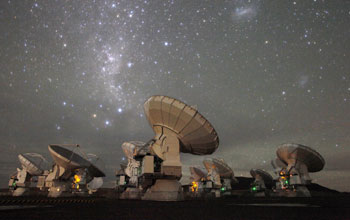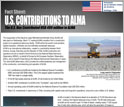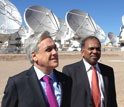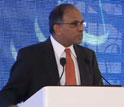News Release 13-040
National Science Foundation Celebrates Inauguration of Atacama Large Millimeter/submillimeter Array (ALMA) in Chile

The antennas of ALMA scrutinize the mysteries of the universe 24 hours a day.
March 13, 2013
This material is available primarily for archival purposes. Telephone numbers or other contact information may be out of date; please see current contact information at media contacts.
The U.S. National Science Foundation (NSF), in collaboration with its Canada and Taiwan partners, Japan, Europe and Chile, inaugurated the Atacama Large Millimeter/submillimeter Array (ALMA) today, one of the world's most powerful telescopes, as part of an international ceremony in Chile.
Chilean President Sebastián Piñera, members of the Chilean cabinet, U.S. NSF Director Subra Suresh, European Southern Observatory Director General Tim de Zeeuw, Senior Vice Minister in Japan's Ministry of Education, Culture, Sports, Science and Technology Teru Fukui, and senior officials and scientists of partner countries participated in the inauguration.
ALMA comprises 66 antennas that will provide high resolution images of the earliest galaxies in the distant universe, as well as the formation processes of planets circling stars in our own Milky Way galaxy. Scientists from around the world will have the opportunity to explore such objects as they never could before, with an array of telescopes more than 100 times more capable than any previous millimeter arrays.
"NSF is excited to play a major role in ALMA and to foster new opportunities for international collaboration and discoveries at the cutting edge of astronomy," said Suresh. "ALMA promises to enable transformational research into the origins and evolution of the universe."
NSF supported the construction of ALMA with $499 million over 11 years and funded 25 of the 66 antennas. The agency's annual contributions to the operations of ALMA total $34 million.
"We are proud of the U.S contribution to ALMA and the international partnership that has made ALMA possible," said U.S. Ambassador to Chile Alejandro D. Wolff. "U.S.-Chile collaboration in astronomy dates back to 1849. The data and science gathered from ALMA will build on other U.S. investments in Chile, including the Cerro Tololo Inter-American Observatory, Las Campanas Observatory and Gemini Observatory."
ALMA is located at an altitude of 16,500 feet in the desert of Atacama, Chile. It sits above 40 percent of the Earth's atmosphere and virtually all of the world's water vapor. ALMA is designed to peer into a slice of the electromagnetic spectrum at millimeter wavelengths--light that is closer to a radio wave than to the optical light that is seen by the human eye.
Together with NASA's future James Webb Space Telescope, ALMA will reveal extraordinary details of the origins of structures in our universe, extending from planets around nearby stars to the earliest galaxies as they formed more than 12 billion years ago.
The National Radio Astronomy Observatory (NRAO), an NSF facility, has led the North American technical and scientific contributions to ALMA. Managed by Associated Universities, Inc. since its inception more than 50 years ago, NRAO has remained at the frontier of radio astronomy research through the conception, development and operation of transformational facilities such as ALMA.
-NSF-
-
View Video
Astronauts on board the International Space Station send greetings for the inauguration of ALMA.
Credit and Larger Version -
Fact Sheet on US contributions to ALMA, provided by the US Embassy in Santiago, Chile.
Credit and Larger Version -
NSF Director Subra Suresh tours ALMA's Array Operations Site with Chile President Sebastián Piñera.
Credit and Larger Version -
View Video
NSF Director at the ALMA Dedication
Credit and Larger Version
Media Contacts
Dana Topousis, NSF, (703) 292-7750, email: dtopousi@nsf.gov
Related Websites
NRAO’s Atacama Large Millimeter/submillimeter Array (ALMA) Website: http://www.nrao.edu/index.php/about/facilities/alma
NSF Briefing on Research Investments in Chile: http://www.nsf.gov/news/mmg/mmg_disp.cfm?med_id=73914&from=search_list
Bursts of Star Formation in the Early Universe: http://www.nsf.gov/news/news_summ.jsp?cntn_id=127219
NSF’s Science Nation Video about ALMA: http://www.nsf.gov/news/special_reports/science_nation/alma.jsp
The U.S. National Science Foundation propels the nation forward by advancing fundamental research in all fields of science and engineering. NSF supports research and people by providing facilities, instruments and funding to support their ingenuity and sustain the U.S. as a global leader in research and innovation. With a fiscal year 2023 budget of $9.5 billion, NSF funds reach all 50 states through grants to nearly 2,000 colleges, universities and institutions. Each year, NSF receives more than 40,000 competitive proposals and makes about 11,000 new awards. Those awards include support for cooperative research with industry, Arctic and Antarctic research and operations, and U.S. participation in international scientific efforts.
Connect with us online
NSF website: nsf.gov
NSF News: nsf.gov/news
For News Media: nsf.gov/news/newsroom
Statistics: nsf.gov/statistics/
Awards database: nsf.gov/awardsearch/
Follow us on social
Twitter: twitter.com/NSF
Facebook: facebook.com/US.NSF
Instagram: instagram.com/nsfgov




